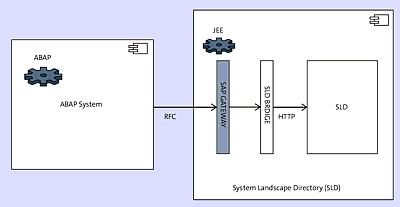3.2 Registering Systems to the System Landscape Directory
As the previous section explained, it’s important to make all participating systems in your SAP landscape register themselves and report to the SLD. To register your system, you need to create a connection between these systems and the SLD. These connections can be achieved using Remote Function Calls (RFCs) or HTTP and are commonly referred to as data suppliers. Data suppliers collect a range of data from SAP systems, including the following:
- Application servers and instances
- RFC gateways
- SAP products
- Installed software components
- Installed support packages
- Compound systems
- HTTP ports
- Network services
- liveCaches
- SAP message servers
- RFC destinations
- Hosts
- Clients
- Databases
- CIM associations between generated objects
The collected data is periodically sent to the SLD using CIM over HTTP.
3.2.1 Connecting to ABAP-Based Systems
For ABAP-based systems (from SAP Basis release 6.4.0 and up), it’s possible to use data suppliers to send the data to the SLD bridge via an RFC connection and SAP Gateway (as depicted in Figure 3.11). In an ABAP-based system, the data supplier uses data collection programs to collect the needed data. For SAP NetWeaver AS ABAP systems, you can modify data collection programs to change their behavior.
Figure 3.11 Connecting an ABAP System to the SLD
Tip
For an ABAP-based system on SAP Basis release 4.0B and up, use Transaction RZ70 to set up SLD data suppliers.
For SAP systems running on an SAP NetWeaver AS ABAP older than 6.40, you can’t configure data suppliers using Transaction RZ70. This configuration will need to be manually performed for such systems.
3.2.2 Connecting to Java-Based Systems
For Java-based systems, configuration of data suppliers is automatically performed during the installation of the system (see Figure 3.12). You can manually change it afterward using SAP NetWeaver Administrator.
To change the data supplier in a Java-based system, follow these steps:
- Go to the SAP NetWeaver Administrator via http://<hostname>:<port>/nwa.
- Navigate to Configuration • Security • Destinations.
- Change or create a destination with the name “SLD_DataSupplier” and of type HTTP.
- You can now enter or change the details in the URL field to point to the SLD system. Don’t forget to enter the login details under the Logon Data tab.
- Test your destination by using the Ping Destination button.
Figure 3.12 Connecting an SAP NetWeaver AS Java System to the SLD
You also have the option to force an SAP NetWeaver AS Java system to collect and send the data to the SLD server at any given time by performing the following steps:
- Go to the SAP NetWeaver Administrator via http://<hostname>:<port>/nwa.
- Navigate to Configuration • Infrastructure • SLD Data Supplier Configuration.
- Click on the Collect and Send Data button (see Figure 3.13).
Figure 3.13 Forcing an SAP NetWeaver AS Java System to Push Data to the SLD
3.2.3 Connecting to Other Systems
Systems other than ABAP or those based on SAP NetWeaver AS Java can also be connected to the SLD and can send their data using an executable program called sldreg. See Table 3.2 for a summary of the approaches to follow to connect a given application system to the SLD, depending on its type and version.
| System type | Approach |
|---|---|
| SAP system with SAP NetWeaver AS ABAP older than 6.40 | Manually update SLD data. |
| SAP System with SAP NetWeaver AS ABAP equal to or greater than 6.40 | Configure data suppliers to automatically update SLD using Transaction RZ70. |
| SAP system with SAP NetWeaver AS Java older than 7.1 | Configure via the Visual Administrator tool. |
| SAP system with SAP NetWeaver AS Java equal to or greater than 7.1 | Configure via the SAP NetWeaver Administrator tool. |
| Standalone and third party | Manually update SLD data. |
Table 3.2 Overview of Approaches to Connect a System to the SLD
The next section discusses the components and available features of the SLD.


